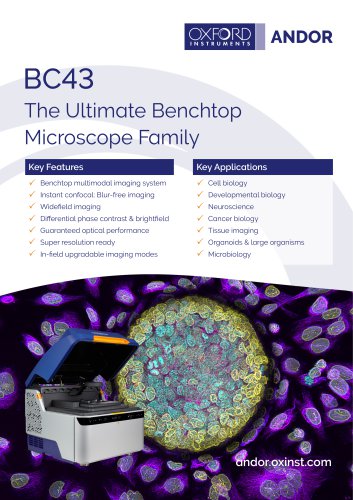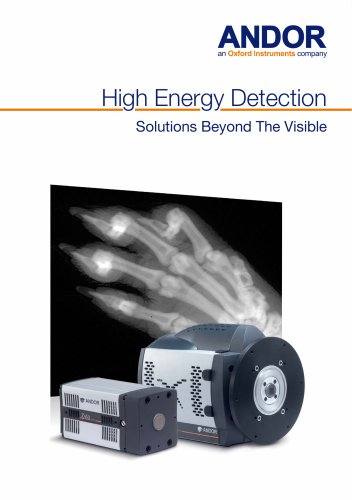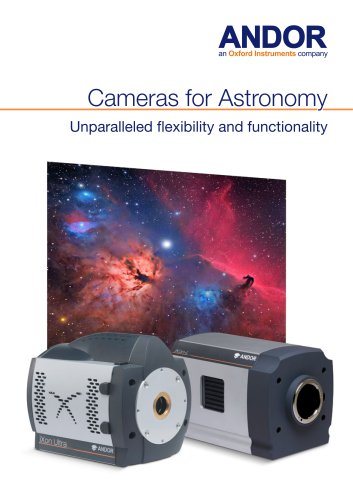
カタログの抜粋

Newton EMCCD A New Approach to Spectroscopy spectroscopy AN DOR™ TECHNOLOGY discover new ways of seeing
カタログの1ページ目を開く
World’s First EMCCD Camera for Spectroscopy Overview 2. Deep Cooling: Minimizing dark current . . . . . . . . . . . . . . . . . . . . . . . . . . . . 3. Minimizing Clock Induced Charge (CIC) . . . . . . . . . . . . . . . . . . . . . . . . . . . 4. Speed of spectral acquisitions . . . . . . . . . . . . . . . . . . . . . . . . . . . . . . . . . . . . 6. Stability and Gain Characteristics . . . . . . . . . . . . . . . . . . . . . . . . . . . . . . . .
カタログの2ページ目を開く
NewtonEM - the choice for Spectroscopy World’s First Electron Multiplying (EMCCD) Camera for Spectroscopy! Sensitivity: single photon sensitive, with 1000X EM gain! Noise: <1 electron, with minimal dark charge & spurious charge. Cooling to -100°C Ultra-Fast Spectral Rate: 600 sp/sec (1300 sp/sec in crop mode) Digitization: 16 bits Quantum Efficiency: >95% USB 2.0 Connectivity Dual Output Amplifiers The NewtonEM delivers the highest sensitivities possible for any CCD camera, offering up to 95% QE and single photon detection. With multi-megahertz readout rates, deep thermoelectric cooling and...
カタログの3ページ目を開く
NewtonEM - the choice for Spectroscopy www.andor.com NewtonEM - the choice for Spectroscopy www.andor.com The NewtonEM Family The NewtonEM comes in two EMCCD models depending on the size of sensor, the DU970N and DU971N. A range of different sensor types, including both front illuminated (FI) and back illuminated (BI), are available depending on the wavelength region of interest and where the highest quantum efficiency (QE) is desirable. The table below summarizes some details of the models available. • The Newton series of EMCCD cameras from Andor Technology offer best in class performance...
カタログの4ページ目を開く
NewtonEM - the choice for Spectroscopy The full benefit of having EM Gain is to be seen in the low photon signal regime... A low signal may arise due to the following scenarios: • The experiment gives intrinsically low signals - e.g. single molecule detection or FRET studies • To facilitate the fastest spectral rates for fine time resolution in fast processes, where the shortest exposures and fastest spectral rates are desirable • Provision of High Dynamic Range through accumulations • Ensuring visibility of very weak signals during alignment and focusing optimization • Excited state...
カタログの5ページ目を開く
NewtonEM - the choice for Spectroscopy Key Performance Features 1. Sensitivity The Newton EMCCD uses the latest EM technology to enhance the signal/noise for measurements in low signal level or photon starved experimental setups. The basic principles behind this technology are illustrated in the figure below. The following examples illustrate the power of EM gain when measuring moderate to weak spectra. In figure 2, spectra taken at moderate and low signal levels are compared for a conventional CCD mode and an EMCCD mode of acquisition using a Newton DU971N_BV camera. The same set up...
カタログの6ページ目を開く
NewtonEM - the choice for Spectroscopy In this ultra-low light regime EM gain can recover successfully the spectral signal with a good S/N ratio, unlike the conventional CCD where only a few of the stronger features are barely observable. The benefits of the EM gain are clearly evident, where the low spectral signal has been lifted above the read noise floor, resulting in a meaningful measurement, whilst for the conventional CCD the signal has by and large remained buried in the noise. Such performance is particularly relevant to those types of applications where: • Pulsed spectroscopy is...
カタログの7ページ目を開く
NewtonEM - the choice for Spectroscopy Raman spectra taken from micro-beads, as used in biochemistry investigations, are shown in figure 6 below illustrating the potential of EM gain to facilitate reduced exposure times or reduce laser power. Baseline offset by 6x105 for display purposes EM gain 250 - 1s Reduce exposure time by ~50X! Conventional 50s Figure 6 Raman spectra illustrating the versatility of an EMCCD to reduce exposure time or to reduce excitation power. (The offset is just used to move the baseline of the top spectra up for display purposes) The potential to use lower...
カタログの8ページ目を開く
NewtonEM - the choice for Spectroscopy 3. Minimizing Clock Induced Charge (CIC) Temp: -55ºC Figure 8 Influence of reduction in sensor temperature on dark noise events. (The images were taken with an exposure time of 20ms and an EM software gain setting of 250) This ensures that dark current events will be exposed as sharp spikes particularly at the lower temperatures where EM gain is highest. They were also taken with settings that minimized the possibility of CIC events (discussed later). Clearly there is a striking reduction in dark current events with reduction in temperature. Cooling...
カタログの9ページ目を開く
NewtonEM - the choice for Spectroscopy www.andor.com 4. Speed of spectral acquisitions The speed at which the data can be read from the sensor depends on two key parameters of the sensor functions, a) the pixel readout rate (readout register) and b) the vertical shift speed (VSS), and whether binning is being used or not. Sensors for spectroscopy are designed to be long and narrow. More often than not full vertical binning (FVB) mode is used, to ensure the capture of individual spectra at the highest possible rates. The pixel readout rate is the speed at which charge can be shunted...
カタログの10ページ目を開く
NewtonEM - the choice for Spectroscopy 5. Multi-track Spectroscopy In some applications it is desirable to capture several independent spectra at the same time on the same sensor. Typically the spectra are captured as tracks on the sensor in the spatial/vertical dimension and the signals are coupled into the spectrograph via a multi-channel fibre. Many tracks can be catered for on the DU970N and DU971N models of the Newton with their sensor heights of 3.2 and 6.4mm respectively. The problem ultimately with using narrower tracks and more of them is the sensitivity required for the resultant...
カタログの11ページ目を開く
NewtonEM - the choice for Spectroscopy 6. Stability and Gain Characteristics EMCCD cameras are susceptible to a number of factors which can impact on data acquisition stability and consequently on the accuracy of quantitative measurements. It is of critical importance that these are addressed to ensure reliable quantitative capture and analysis of data. The two main tools in the Newton platform to ensure stability are baseline clamping and optimized temperature stability. Baseline Clamping A baseline or bias level is an applied DC offset added to the output signal from the EMCCD sensor when...
カタログの12ページ目を開くAndor Technologyのすべてのカタログと技術パンフレット
-
Marana sCMOS
9 ページ
-
MicroPoint 4
9 ページ
-
ZL41 Cell sCMOS
7 ページ
-
Sona sCMOS
9 ページ
-
Optistat
11 ページ
-
Multi-Wavelength Imaging
11 ページ
-
BC43
13 ページ
-
Solis-Brochure
6 ページ
-
iKon-M/L SO Series
10 ページ
-
iStar CCD and sCMOS
8 ページ
-
Neo 5.5 sCMOS
6 ページ
-
Mechelle 5000
5 ページ
-
Spectroscopy Brochure
25 ページ
-
Apogee Alta F9000
5 ページ
-
Apogee Aspen CG230
5 ページ
-
Apogee Aspen CG47
5 ページ
-
Apogee Aspen CG6
5 ページ
-
ApogeeAspen CG9000
5 ページ
-
iXon EMCCD
13 ページ
-
iVac OEM 2
2 ページ
-
iKon-M OEM 2-page PV
2 ページ
-
iKon-M X-Ray 2
2 ページ
-
iQ Software
12 ページ
-
sCMOS
16 ページ
-
Low Light Imaging
8 ページ
-
Darkcurrent
3 ページ
-
Revolution
23 ページ
-
Clara Flyer
2 ページ
-
PRODUCT PORTFOLIO 2013
51 ページ
-
Revolution DSD
11 ページ
-
Neo and Zyla sCMOS
27 ページ
-
iXon
33 ページ
カタログアーカイブ
-
Astronomy Brochure_2014
19 ページ
-
Astronomy Brochure
19 ページ

























































